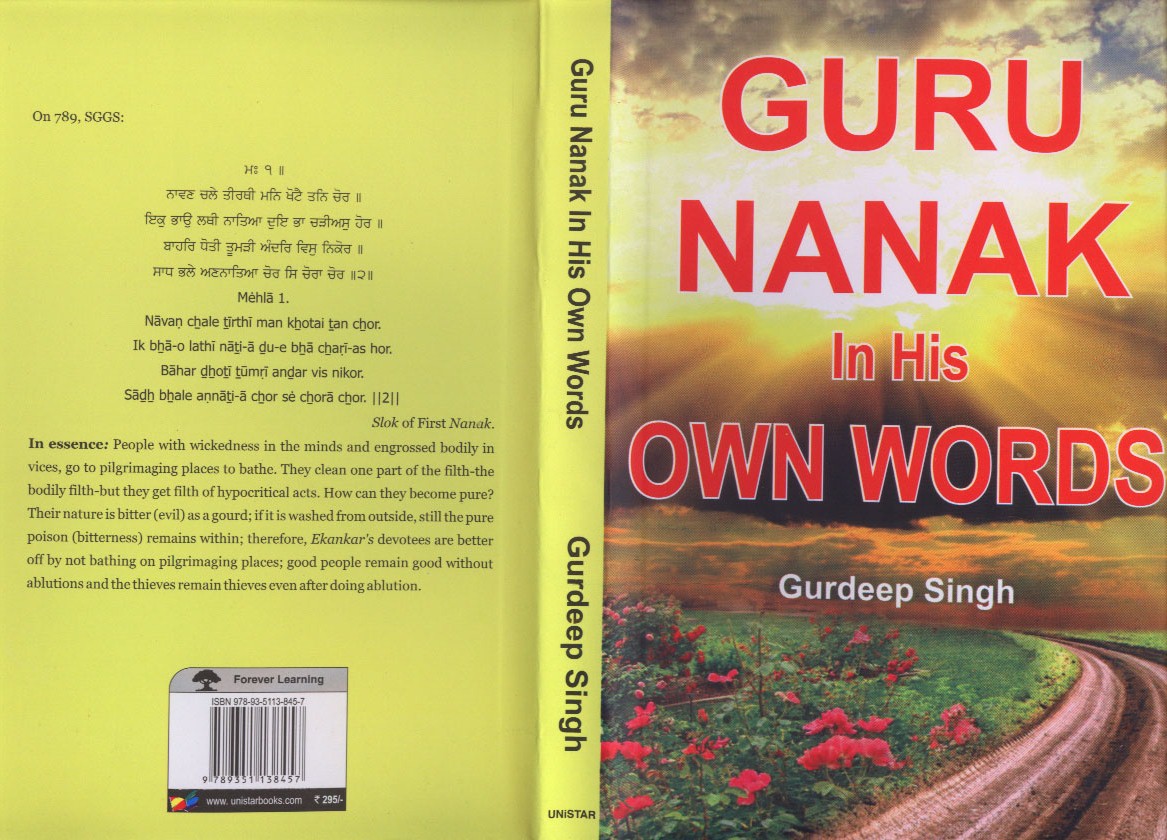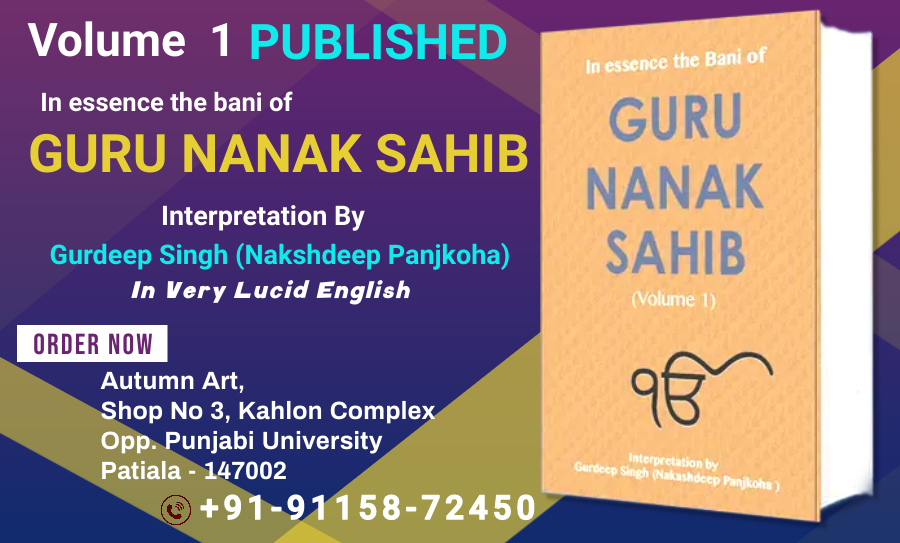 In Punjab, India, there is a picture of Darbar Sahib on sale everywhere; on that picture there is a Gurbani-verse,
In Punjab, India, there is a picture of Darbar Sahib on sale everywhere; on that picture there is a Gurbani-verse,
ਹਰਿ ਮੰਦਰੁ ਹਰਿ ਜੀਉ ਸਾਜਿਆ ਰਖਿਆ ਹੁਕਮਿ ਸਵਾਰਿ॥
Har manḏar har jī▫o sāji▫ā rakẖi▫ā hukam savār.
but it has nothing to do with the of picture of Darbar Sahib. Its usage is misleading, because it is not about Har Mandir Sahib, Amritsar, but about the human body in which Akalpurakh resides hidden. Indeed, where Akalpurakh’s praise is sung always His presence is perceived, but it doesn’t mean Akalpurakh is present only at that place. HE is present everywhere: at the places of His praise, in all the lives and all other places as the Guru says in Japji on 4, SGGS
ਜੇਤਾ ਕੀਤਾ, ਤੇਤਾ ਨਾਉ ॥
Jeṯā kīṯā ṯeṯā nā▫o.
Darbar Sahib is indeed very dear to all the Guru’s followers, but to promote “Har Mandir Sahib” as Har’s house created by Him in Amritsar is misleading. Let us today look at the Guru’s that shabda through which he leads his follower to search Him within the body instead of anyone place; the shabda is on 1346, SGGS
ਪ੍ਰਭਾਤੀ ਮਹਲਾ ੩ ਬਿਭਾਸ
Parbẖāṯī mėhlā 3 bibẖās
ੴ ਸਤਿਗੁਰ ਪ੍ਰਸਾਦਿ ॥
Ik▫oaʼnkār saṯgur parsāḏ
ਗੁਰ ਪਰਸਾਦੀ ਵੇਖੁ ਤੂ ਹਰਿ ਮੰਦਰੁ ਤੇਰੈ ਨਾਲਿ ॥
ਹਰਿ ਮੰਦਰੁ ਸਬਦੇ ਖੋਜੀਐ ਹਰਿ ਨਾਮੋ ਲੇਹੁ ਸਮ੍ਹ੍ਹਾਲਿ ॥੧॥
Gur parsādī vekẖ ṯū har manḏar ṯerai nāl.
Har manḏar sabḏe kẖojī▫ai har nāmo leho samĥāl. ||1||
In essence: Har’s abode is with you; see it through the Guru’s blessings. Har’s abode is searched by the Guru’s shabda. Keep holding to His name.
The Guru advises the follower to find the presence of the Creator within. First thing is to get involved in His name praise through the Guru’s shabda. On 1418, SGGS, in a slok, the Guru expresses the same idea with special advice, please read it:
ਹਰਿ ਮੰਦਰੁ ਹਰਿ ਸਾਜਿਆ ਹਰਿ ਵਸੈ ਜਿਸੁ ਨਾਲਿ ॥
ਗੁਰਮਤੀ ਹਰਿ ਪਾਇਆ ਮਾਇਆ ਮੋਹ ਪਰਜਾਲਿ ॥
ਹਰਿ ਮੰਦਰਿ ਵਸਤੁ ਅਨੇਕ ਹੈ ਨਵ ਨਿਧਿ ਨਾਮੁ ਸਮਾਲਿ ॥
ਧਨੁ ਭਗਵੰਤੀ ਨਾਨਕਾ ਜਿਨਾ ਗੁਰਮੁਖਿ ਲਧਾ ਹਰਿ ਭਾਲਿ ॥
ਵਡਭਾਗੀ ਗੜ ਮੰਦਰੁ ਖੋਜਿਆ ਹਰਿ ਹਿਰਦੈ ਪਾਇਆ ਨਾਲਿ ॥੪੮॥
Har manḏar har sāji▫ā har vasai jis nāl.
Gurmaṯī har pā▫i▫ā mā▫i▫ā moh parjāl.
Har manḏar vasaṯ anek hai nav niḏẖ nām samāl.
Ḏẖan bẖagvanṯī nānkā jinā gurmukẖ laḏẖā har bẖāl.
Vadbẖāgī gaṛ manḏar kẖoji▫ā har hirḏai pā▫i▫ā nāl. ||48||
In essence: Har has created His abode (this body temple) and He lives in it Through the Guru’s guidance and by burning the love of Maya, Har is obtained. In this Har’s abode, there are many invaluable virtues; therefore, remember Har, the nine treasures. Oh Nanak! Those Guru’s followers, who have found Har’s through the Guru, are fortunate and blessed ones. With great luck, this body is searched and Har is found in the heart.
ਮਨ ਮੇਰੇ ਸਬਦਿ ਰਪੈ ਰੰਗੁ ਹੋਇ ॥
ਸਚੀ ਭਗਤਿ ਸਚਾ ਹਰਿ ਮੰਦਰੁ ਪ੍ਰਗਟੀ ਸਾਚੀ ਸੋਇ ॥੧॥ ਰਹਾਉ ॥
Man mere sabaḏ rapai rang ho▫e.
Sacẖī bẖagaṯ sacẖā har manḏar pargatī sācẖī so▫e. ||1|| rahā▫o.
Oh my mind! One, who gets drenched in the Guru’s shabda, develops love for Har. Through Har’s true devotion, His true abode becomes manifest and then one gets true glory. Pause.
Finding the Creator within is not very simple task; first one has to develop an urge to realize Him; then one needs to devote one’s full attention toward Him in love. What the Guru says must be believed. If under the outer influences, the mind doesn’t accept or believe that indeed His presence is within, one remains in doubt. Now the Guru openly explains what is His temple and how He becomes manifest in it.
ਹਰਿ ਮੰਦਰੁ ਏਹੁ ਸਰੀਰੁ ਹੈ ਗਿਆਨਿ ਰਤਨਿ ਪਰਗਟੁ ਹੋਇ ॥
ਮਨਮੁਖ ਮੂਲੁ ਨ ਜਾਣਨੀ ਮਾਣਸਿ ਹਰਿ ਮੰਦਰੁ ਨ ਹੋਇ ॥੨॥
Har manḏar ehu sarīr hai gi▫ān raṯan pargat ho▫e.
Manmukẖ mūl na jāṇnī māṇas har manḏar na ho▫e. ||2||
This body is a home of Har, but He becomes manifest through the precious divine knowledge (the Guru’s teachings). The mind-slaves do not know the source of the world, Har; therefore, they don’t think this body can be Har’s abode.
Most of the people, who believe that they know everything, fail to realize the mystic experience of the Guru because of their self-conceit. First full faith in His presence within and very honest urge to envision Him must be developed. The Guru enlightens his followers by removing their duality, doubts, attachment, greed, lust, anger and conceit.
ਹਰਿ ਮੰਦਰੁ ਹਰਿ ਜੀਉ ਸਾਜਿਆ ਰਖਿਆ ਹੁਕਮਿ ਸਵਾਰਿ ॥
ਧੁਰਿ ਲੇਖੁ ਲਿਖਿਆ ਸੁ ਕਮਾਵਣਾ ਕੋਇ ਨ ਮੇਟਣਹਾਰੁ ॥੩॥
Har manḏar har jī▫o sāji▫ā rakẖi▫ā hukam savār.
Ḏẖur lekẖ likẖi▫ā so kamāvaṇā ko▫e na metaṇhār. ||3||
Har has created this temple (body) and He has embellished it with His Ordinance. One lives as per one’s destiny and no one can erase it.
It is not in our hands to realize Him as we want. Please look at the following verses of Japji in which the Guru explains how we are totally bound in the Creator’s order; the Guru’s advice helps to get rid of our false illusion of knowing everything and capability of doing everything:
Pauri/Stanza – 33
ਆਖਣਿ ਜੋਰੁ ਚੁਪੈ ਨਹ ਜੋਰੁ ॥
ਜੋਰੁ ਨ ਮੰਗਣਿ ਦੇਣਿ ਨ ਜੋਰੁ ॥
Aakhan jor chupai nah jor.
Jor na mangan dayn na jor.
Neither we have power to speak, nor do we have power to be silent. We have no power to ask/beg or to give away (anything).
ਜੋਰੁ ਨ ਜੀਵਣਿ ਮਰਣਿ ਨਹ ਜੋਰੁ ॥
ਜੋਰੁ ਨ ਰਾਜਿ ਮਾਲਿ ਮਨਿ ਸੋਰੁ ॥
Jor na jeevan maran nah jor.
Jor na raaj maal man sor.
We have no power to live, or power to die. It is not in our power to obtain power to rule or to have wealth that creates commotion in the mind.
ਜੋਰੁ ਨ ਸੁਰਤੀ ਗਿਆਨਿ ਵੀਚਾਰਿ ॥
ਜੋਰੁ ਨ ਜੁਗਤੀ ਛੁਟੈ ਸੰਸਾਰੁ ॥
Jor na surtee gi–aan veechaar.
Jor na jugtee chhutai sansaar.
We have no power to understand the divine knowledge, or to meditate. We have no power, which can liberate us from this world.
Then who has all this power? The Guru answers it in the next verse:
ਜਿਸੁ ਹਥਿ ਜੋਰੁ ਕਰਿ ਵੇਖੈ ਸੋਇ ॥
ਨਾਨਕ ਉਤਮੁ ਨੀਚੁ ਨ ਕੋਇ ॥੩੩॥
Jis hath jor kar vekẖai so▫e.
Naanak utam neech na ko–ay. ||33||
Ekankaar, who has all this power, creates and watches His creation. Thus there is only one, who has this mighty power, and it is the Master of the universe, who after fashioning the creation exercises His power to watch it. Oh Nanak! There is no one high or low (in His consideration).
It is we who have habit of seeing people as low or high. The Guru, while addressing Prabh’s mighty power and our being powerless, also hints at manmade races or castes and tells that for Prabh, there is no such thing like caste or race.
Thus, the path is revealed through the Guru or a Peer. As one follows that path, the Creator’s ordinance is understood and it is realized that the most sublime act is to live in His love obeying His ordinance. Only those who reflect on the Guru’s teachings become successful in this regard.
ਸਬਦੁ ਚੀਨ੍ਹ੍ਹਿ ਸੁਖੁ ਪਾਇਆ; ਸਚੈ ਨਾਇ ਪਿਆਰ ॥
ਹਰਿ ਮੰਦਰੁ ਸਬਦੇ ਸੋਹਣਾ; ਕੰਚਨੁ ਕੋਟੁ ਅਪਾਰ ॥੪॥
Sabaḏ cẖīnėh sukẖ pā▫i▫ā sacẖai nā▫e pi▫ār.
Har manḏar sabḏe sohṇā kancẖan kot apār. ||4||
Those persons, who have developed love for Him, realize His name and obtain peace. Through the Guru’s shabda, the Infinite Har’s beautiful fortress of gold (virtues) is realized
ਹਰਿ ਮੰਦਰੁ ਏਹੁ ਜਗਤੁ ਹੈ; ਗੁਰ ਬਿਨੁ ਘੋਰੰਧਾਰ ॥
ਦੂਜਾ ਭਾਉ ਕਰਿ ਪੂਜਦੇ; ਮਨਮੁਖ ਅੰਧ ਗਵਾਰ ॥੫॥
Har manḏar ehu jagaṯ hai gur bin gẖoranḏẖār.
Ḏūjā bẖā▫o kar pūjḏe manmukẖ anḏẖ gavār. ||5||
The entire world is Har’s abode, but without the Guru, there is all darkness (it is not realized); the foolish and ignorant mind-slaves worship in other’s love.
The duality and the worldly influences don’t let the mind convinced that the presence of the Creator is everywhere and in all; consequently, as guided by doubt and illusions, the mortal starts worshiping other entities ignoring the all powerful and all doer, Ekankaar. He starts building homes for the Creator believing that in them, He will reside leaving the entire world unattended.
ਜਿਥੈ ਲੇਖਾ ਮੰਗੀਐ; ਤਿਥੈ, ਦੇਹ ਜਾਤਿ ਨ ਜਾਇ ॥
ਸਾਚਿ ਰਤੇ ਸੇ ਉਬਰੇ; ਦੁਖੀਏ ਦੂਜੈ ਭਾਇ ॥੬॥
Jithai lekẖā mangī▫ai ṯithai ḏeh jāṯ na jā▫e.
Sācẖ raṯe se ubre ḏukẖī▫e ḏūjai bẖā▫e. ||6||
Where the accounts are called in, the body and caste do not go, and there, those, who get drenched in Prabh’s love, become distinguished, but those, who are into other’s love, become miserable.
The Guru advises that where the deeds are weighed, one’s body or caste doesn’t go; therefore, only those win, who get imbued with the Creator, and the others in dual love suffer.
ਹਰਿ ਮੰਦਰ ਮਹਿ ਨਾਮੁ ਨਿਧਾਨੁ ਹੈ; ਨਾ ਬੂਝਹਿ ਮੁਗਧ ਗਵਾਰ ॥
ਗੁਰ ਪਰਸਾਦੀ ਚੀਨ੍ਹ੍ਹਿਆ; ਹਰਿ ਰਾਖਿਆ ਉਰਿ ਧਾਰਿ ॥੭॥
Har manḏar mėh nām niḏẖān hai nā būjẖėh mugaḏẖ gavār.
Gur parsādī cẖīnĥi▫ā har rākẖi▫ā ur ḏẖār. ||7||
The foolish ignorant mortals do not understand that Har’s name treasure is in the body, which is Har’s temple. Those ones, who through the Guru realize this, enshrine Har in their hearts.
Duality doesn’t let the foolish mortal realize that Akalpurakh exists within the body; Akalpurakh’s name and love for it is already there, but he doesn’t know how to grow it within; nonetheless, if he follows the Guru, he can realize His presence within.
ਗੁਰ ਕੀ ਬਾਣੀ, ਗੁਰ ਤੇ ਜਾਤੀ; ਜਿ ਸਬਦਿ ਰਤੇ ਰੰਗੁ ਲਾਇ ॥
ਪਵਿਤੁ ਪਾਵਨ, ਸੇ ਜਨ ਨਿਰਮਲ; ਹਰਿ ਕੈ ਨਾਮਿ ਸਮਾਇ ॥੮॥
Gur kī baṇī gur ṯe jāṯī jė sabaḏ raṯe rang lā▫e.
Paviṯ pāvan se jan nirmal har kai nām samā▫e. ||8||
The Guru’s bani is understood through the Guru if one gets drenched in his shabda. Those persons, who get absorbed in Har’s name, become pure and immaculate.
When the follower makes the Guru’s teaching his guiding force, he falls in love with the Creator; only the Guru can make him realize that. Being in love with the Creator, the Guru’s follower gets absorbed in the Creator while alive. The worldly attractions cannot influence him negatively.
ਹਰਿ ਮੰਦਰੁ ਹਰਿ ਕਾ ਹਾਟੁ ਹੈ; ਰਖਿਆ ਸਬਦਿ ਸਵਾਰਿ ॥
ਤਿਸੁ ਵਿਚਿ ਸਉਦਾ, ਏਕੁ ਨਾਮੁ; ਗੁਰਮੁਖਿ ਲੈਨਿ ਸਵਾਰਿ ॥੯॥
Har manḏar har kā hāt hai rakẖi▫ā sabaḏ savār.
Ŧis vicẖ sa▫uḏā ek nām gurmukẖ lain savār. ||9||
The body temple is Har’s shop and the Guru’s shabda can decorate it; only Har’s name merchandise is in Har’s shop (the body); the Guru followers get it and become embellished.
Obviously, the body is a shop in which the trade of praising His name should be done. It is this very shop that becomes important not any other special place. If it is not used for His praise, worthless is visiting religious places to search Him.
ਹਰਿ ਮੰਦਰ ਮਹਿ, ਮਨੁ ਲੋਹਟੁ ਹੈ; ਮੋਹਿਆ ਦੂਜੈ ਭਾਇ ॥
ਪਾਰਸਿ ਭੇਟਿਐ ਕੰਚਨੁ ਭਇਆ; ਕੀਮਤਿ ਕਹੀ ਨ ਜਾਇ ॥੧੦॥
Har manḏar mėh man lohat hai mohi▫ā ḏūjai bẖā▫e.
Pāras bẖeti▫ai kancẖan bẖa▫i▫ā kīmaṯ kahī na jā▫e. ||10||
In this body, Har’s abode, the mind remains just like iron (not virtuous), because it is lured by other’s love. Those persons, who meet the Guru, the Paras (philosopher’s stone), become gold (virtuous), and their worth is beyond words. In the following, the Guru finally makes it clear that as the Creator is present all over, but He is very much present in the body as well:
ਹਰਿ ਮੰਦਰ ਮਹਿ ਹਰਿ ਵਸੈ; ਸਰਬ ਨਿਰੰਤਰਿ ਸੋਇ ॥
ਨਾਨਕ, ਗੁਰਮੁਖਿ ਵਣਜੀਐ; ਸਚਾ ਸਉਦਾ ਹੋਇ ॥੧੧॥੧॥
Har manḏar mėh har vasai sarab niranṯar so▫e.
Nānak gurmukẖ vaṇjī▫ai sacẖā sa▫uḏā ho▫e. ||11||1||
This body is Har’s temple, in which resides Har, who is permeating equally all the lives. Oh Nanak! If a person deals in Har’s name through the Guru, only then his trade becomes successful forever.
Let us realize our Creator and feel His presence in all. Let us worship Him only. Let us make Him happy by acquiring virtues by abandoning our flaws. Let us praise Him heartily. The real trade is to become worthy of Him. The worldly trade is a part of His show; therefore, we should not allow this show to take us away from Him. There is not special place where He is present; obviously, we should not be bound by what other say but our Guru, who says our Creator is pervading everywhere and He is present in all equally.
Wishes
Humbly
G Singh









